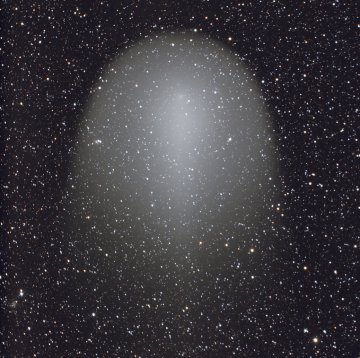 Where's Saturn? Is that a UFO--or the ISS? What's the name of that star? Get the answers from mySKY--a fun new astronomy helper from Meade. Where's Saturn? Is that a UFO--or the ISS? What's the name of that star? Get the answers from mySKY--a fun new astronomy helper from Meade. SPACECRAFT FLYBY: NASA's Deep Impact spacecraft, which blasted a hole in Comet Tempel 1 in 2005, is en route to another comet, Hartley 2, for a less violent examination in 2010. First, though, the spacecraft now known as EPOXI must fly by Earth for a gravity assist. Closest approach takes place on Dec. 31, 2007, and may be observed through backyard telescopes in Australia and southeast Asia: full story. DON'T FORGET: "Comet 17P/Holmes is still big and beautiful," reports Chris Schur of Payson, Arizona. "Here is the latest deep exposure from last night." 
"The comet is easy to see with the naked eye from dark-sky sites and is growing more gigantic every day," he says. Indeed, the main problem with telescopic observations is fitting the oversized comet in the eyepiece. Binoculars and small telescopes work best. Look north after sunset: sky map. PEARLY CLOUDS: In Porjus, Sweden, sky watcher Patricia Cowern has sighted "the first mother of pearl clouds of the winter." She snapped this picture on Dec. 16th: 
"Mother of pearl or nacreous clouds are one of Nature's most spectacular sights," says atmospheric optics expert Les Cowley. "As far south as England we only get to see them every five years or so, but every appearance is spectacular and memorable." They are so rare because extreme cold is required to produce them. "Nacreous clouds are 9-16 miles (15-25km) high and way above ordinary clouds and weather. Their tiny ice crystals need exceptionally low temperatures of minus 85 Celsius (-120 F) to form." "In winter at high latitudes and especially downwind of mountains they are stunning after sunset or before dawn. Watch them shine brightly with slowly changing iridescent colors as they are twisted and stretched by gravity waves in the upper atmosphere."
Comet 8P/Tuttle Photo Gallery
[World Map of Comet Sightings]
[sky map] [comet cameras] [ephemeris] [orbit] | 
